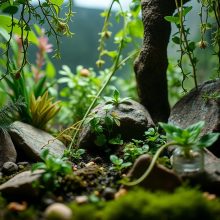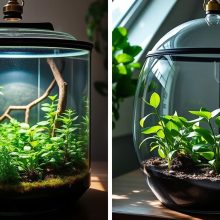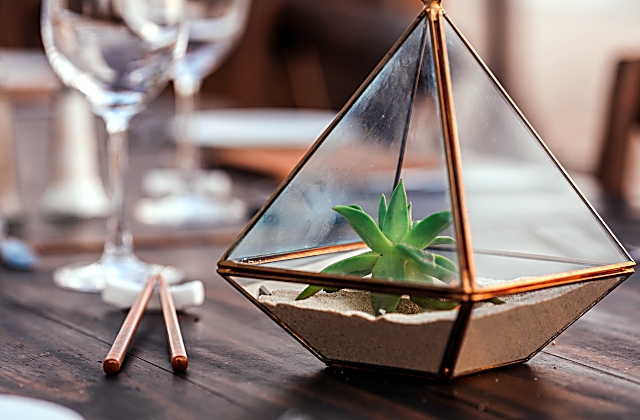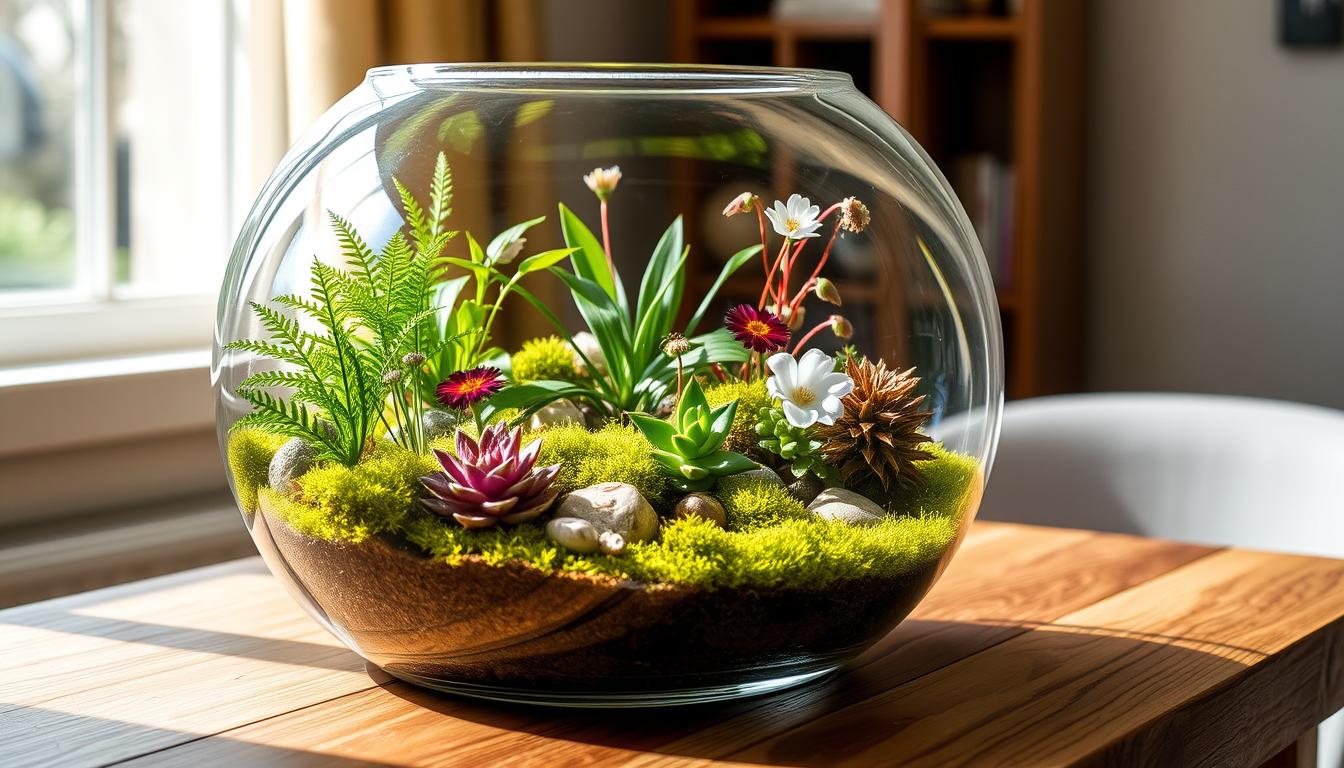Terrarium Care Tips: A Beginner’s Guide
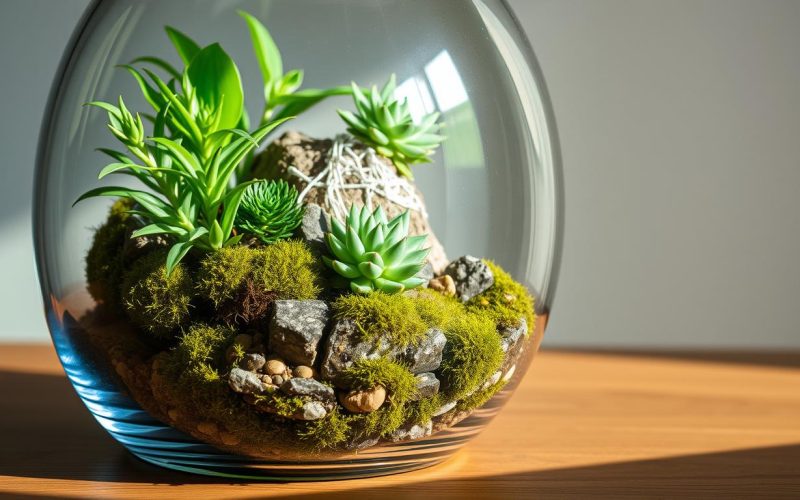
Terrariums are a cool way for plant lovers to make mini worlds in glass. They let you grow different plants with little work. Learning how to care for a terrarium can make your indoor gardening better, creating a mini landscape that thrives.
Good terrarium care means knowing about moisture, light, and picking the right plants. Beginners can learn to care for terrariums by following a few key rules. Each terrarium is its own special place that needs the right care to keep plants healthy and thriving.
Want a desert or a lush tropical terrarium? The right tips can help you make a beautiful, lasting mini garden. Knowing how to care for your terrarium lets you create a stunning display of nature in your home or office.
Key Takeaways
- Terrariums create self-sustaining miniature ecosystems
- Proper plant selection is crucial for terrarium success
- Understanding moisture and light requirements is essential
- Terrariums offer low-maintenance indoor gardening
- Each terrarium requires unique care strategies
Understanding the Basics of Terrariums
Terrariums are tiny worlds that bring nature inside. They are glass containers that let plants grow with little care. These spaces are perfect for small areas, making it easy to keep them green.
What Exactly is a Terrarium?
A terrarium is a glass container filled with plants. It’s like a mini garden that needs little care. The glass keeps moisture in, creating a special place for plants to grow.
Different Types of Terrariums
- Open Terrariums: Good for plants that like air, like succulents.
- Closed Terrariums: For plants that love humidity, like tropical ones.
- Geometric Terrariums: Modern and sleek, with clean lines.
- Hanging Terrariums: Hangs from the ceiling, adding height to rooms.
Benefits of Having a Terrarium
Terrariums are great for those who love plants and decorating. They clean the air, reduce stress, and look beautiful. These tiny gardens are easy to care for and can make any room feel like a natural oasis.
- Low maintenance plant care
- Improved indoor air quality
- Stress reduction
- Decorative home element
Choosing the Right Container for Your Terrarium
Starting your DIY terrarium journey means picking the perfect container. The right terrarium vessel is key to your mini-ecosystem’s health and look. It’s essential for following the best terrarium care practices.
Looking into DIY terrarium care guides, you’ll see many container options. Glass and plastic are the main choices, each with its own benefits.
Glass vs. Plastic Terrariums
- Glass Containers:
- Superior aesthetic appeal
- Better visibility of plant layers
- More durable and scratch-resistant
- Plastic Containers:
- Lightweight and portable
- Less expensive
- Resistant to breaking
Open vs. Closed Terrariums
The design of your terrarium is crucial for plant survival. Best terrarium care practices suggest knowing the open and closed system differences.
- Closed Terrariums:
- Create a self-sustaining ecosystem
- Retain moisture effectively
- Ideal for tropical plants
- Open Terrariums:
- Better air circulation
- Suitable for succulents and cacti
- Require more frequent watering
Choosing the right container means thinking about your plants, space, and style. Try out different styles to find your ideal terrarium.
Selecting the Best Plants for Your Terrarium
Starting a terrarium means picking the right plants. You need to choose species that do well in closed spaces. Not every plant fits well in these tiny worlds, so knowing what they need is key.
For indoor terrariums, pick plants that like the same conditions. Tropical and small plants are great for beginners. They help create a lively mini landscape.
Ideal Plant Species for Beginners
- Fittonia (Nerve Plant): Colorful, low-growing plant perfect for terrariums
- Callisia repens (Turtle Vine): Delicate trailing plant with compact growth
- Peperomia: Compact varieties with interesting leaf textures
- Pilea: Small, round-leafed plants that add visual interest
How to Group Plants Safely
When mixing plants in your terrarium, keep these tips in mind:
- Match plants with similar light needs
- Make sure they like the same humidity
- Use different heights and textures for looks
- Give plants enough room to grow
Good terrarium care means knowing what each plant needs. Choose small, slow-growing plants. They prevent overcrowding and keep the ecosystem balanced.
Soil and Drainage Solutions
Creating the perfect terrarium starts with soil and drainage. These are key terrarium care tips. The right soil and drainage layers protect plants from root rot and provide nutrients.
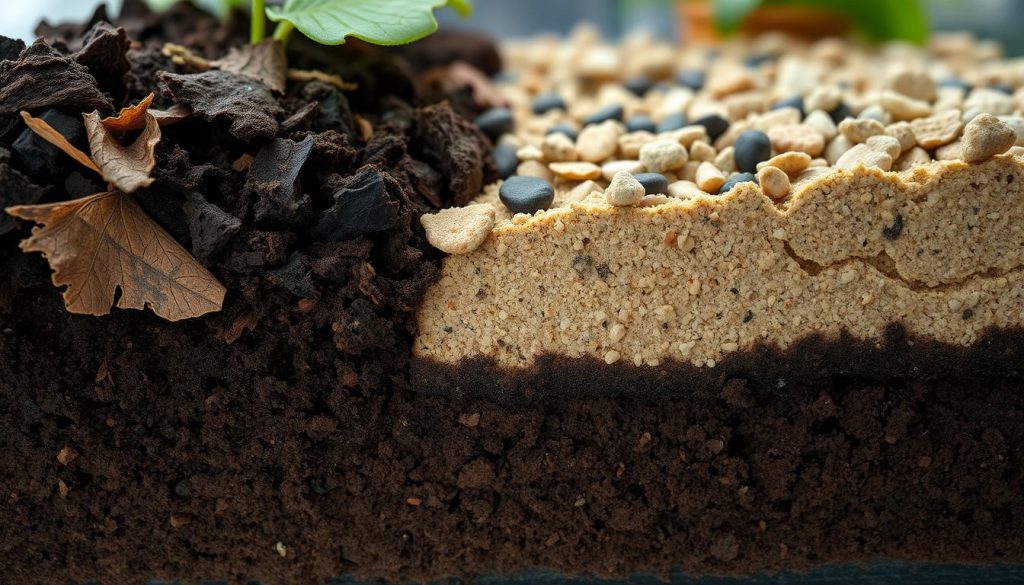
Choosing the right soil is crucial, as experienced gardeners say. Different plants need different soils, but most terrariums do well with a special mix.
Types of Terrarium Soil Mixtures
- Coco coir: Keeps moisture well
- Worm castings: Adds organic nutrients
- Orchid bark: Improves drainage and aeration
- Activated charcoal: Filters and purifies soil
Creating Effective Drainage Layers
The bottom layer of your terrarium is key to preventing water buildup. A good drainage layer keeps excess moisture away from roots. This prevents decay. Terrarium care tips suggest using small pebbles or LECA for this.
- Start with a 1-2 inch drainage layer
- Add activated charcoal to prevent bacterial growth
- Cover with a mesh screen or landscape fabric
- Top with your prepared soil mixture
By following these terrarium care tips, you’ll have a thriving miniature ecosystem. It will stay healthy and vibrant for months or years.
Setting Up Your Terrarium
Creating a DIY terrarium is a fun project that lets you build a mini world. It needs careful planning and detail. Your terrarium care guide will show you how to make a mini garden that thrives.
Gathering Your Materials
Start by gathering everything you need. A good DIY terrarium care guide says to have these items ready:
- Clear glass container
- Drainage pebbles
- Activated charcoal
- Potting soil
- Selected plants
- Small gardening tools
Layering Techniques for Success
Learning how to layer is key for terrarium care. Start with a solid base by following these steps:
- Create a drainage layer using small pebbles (1-2 inches thick)
- Add a thin layer of activated charcoal to prevent bacterial growth
- Place a barrier of moss to separate drainage and soil layers
- Add nutrient-rich potting soil
Planting Your Terrarium
Choose and place your plants wisely. For a DIY terrarium care guide, think about plant size and growth. Make small holes in the soil, gently put roots in, and press soil around the base to secure plants.
Remember, every terrarium is different. Try out various plants and decorations to make a unique mini landscape that shows your creativity.
Watering Your Terrarium
Learning how to care for a terrarium starts with proper watering. Terrariums have their own microclimates that need careful moisture control. Knowing the right terrarium watering tips is key to a healthy mini-ecosystem.
Water is essential for terrariums, but too much or too little can harm your garden. The goal is to find the right balance. This balance keeps your plants healthy without causing root rot or dehydration.
Signs Your Terrarium Needs Water
- Dry soil that looks light brown and cracked
- Wilting or drooping plant leaves
- Plants appearing dull or less vibrant
- Condensation has completely disappeared from glass walls
Common Watering Mistakes to Avoid
- Overwatering: The most frequent error in terrarium care
- Using tap water with harsh chemicals
- Watering directly on plant leaves
- Ignoring individual plant water requirements
For terrarium care, use a fine mist spray bottle with distilled or rainwater. Spray the inside of the terrarium, focusing on the soil. This method ensures even moisture without harming the roots.
Remember, closed terrariums need less water than open ones. Always check your plants and adjust your watering schedule as needed.
Light Requirements for Terrariums
Creating the perfect environment for your indoor terrarium starts with understanding terrarium sunlight requirements. Proper lighting is crucial for plant health and growth. It’s a key aspect of indoor terrarium maintenance.
Best Lighting Options for Indoor Spaces
Indoor terrariums thrive under specific light conditions. Most plants prefer bright, indirect sunlight. This light mimics their natural forest floor habitat. Here are some top lighting options:
- Bright white LED grow lights (5700K color temperature)
- North or east-facing window exposure
- Filtered light through sheer curtains
- Artificial plant grow lights with adjustable intensity
Strategic Terrarium Positioning Tips
Positioning plays a critical role in indoor terrarium maintenance. Different plants have unique light needs. Careful placement is essential for their survival.
- Avoid direct afternoon sunlight, which can burn delicate terrarium plants
- Rotate terrariums weekly for even light distribution
- Use a light timer for consistent artificial lighting
- Monitor plant response and adjust lighting according
For terrariums in low-light areas, consider supplementing with specialized grow lights. These lights provide the right spectrum of light for plant growth. Remember, terrarium sunlight requirements vary depending on the specific plant species you’ve selected.
Maintaining Humidity Levels
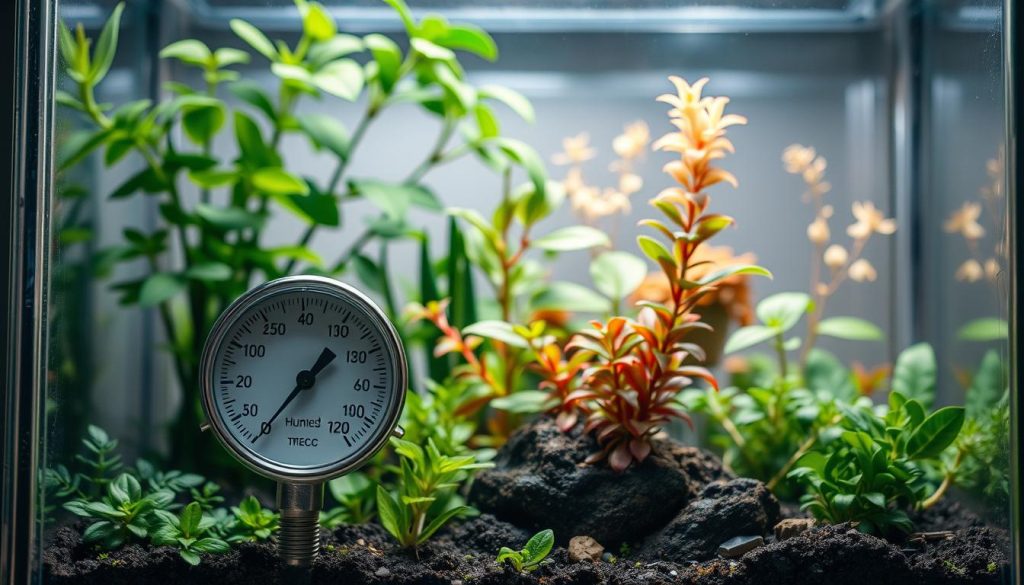
Creating the perfect terrarium environment means paying close attention to humidity. Terrarium care tips stress how important moisture is for plant health. Each terrarium type has its own humidity needs, crucial for its success.
Knowing about terrarium humidity levels is key for a healthy plant habitat. The right moisture balance helps plants grow and avoids problems like stress or fungus.
Measuring Humidity Accurately
To check your terrarium’s humidity, try these methods:
- Use a digital hygrometer for precise measurements
- Look for condensation on the terrarium walls
- Check plant leaf health and soil moisture
Creating the Ideal Humidity Environment
For successful terrarium care, aim for a balanced moisture level. You want to see condensation up to one-third of the terrarium’s height. This shows a healthy humidity that supports growth without being too wet.
Different terrarium types need different humidity levels:
- Closed terrariums keep humidity high
- Open terrariums need more moisture checks
- Tropical plants need more humidity than desert plants
By managing terrarium humidity levels, you can create a thriving mini-ecosystem. It adds life and beauty to any indoor space.
Pruning and Replacing Plants
Keeping terrarium plants healthy and looking good needs careful attention to pruning and replacing. It’s not just about watering and placing them right. You also need to know when and how to trim them to keep them growing well.
Good terrarium care means watching them closely and acting fast. Plants in these closed spaces can grow too big, so pruning is key.
When to Prune Your Terrarium Plants
- When plants touch the terrarium walls
- If stems become leggy or straggly
- To remove dead or yellowing leaves
- To maintain desired plant shape and size
Pruning Techniques for Healthy Growth
Use sharp, clean scissors or tweezers for precise cuts. Cut stems just above a leaf joint to help them grow fuller. Also, remove any mouldy or diseased parts right away to stop it from spreading.
Signs It’s Time to Replace Plants
- Persistent yellowing or browning of leaves
- Lack of growth or stunted development
- Root rot or fungal infections
- Plants that no longer fit the terrarium’s ecosystem
Good plant care keeps your terrarium lively and healthy. By following these tips, you’ll have a miniature garden that’s always a joy to look at.
Troubleshooting Common Terrarium Issues
Learning how to care for a terrarium is key to a healthy mini-ecosystem. Even experts face problems. Knowing common issues helps you fix them fast.
Mold is a big worry for terrarium owners. Too much moisture can cause white or gray patches on soil or plants. To stop this, make sure your terrarium breathes well and water it less. Cut off any moldy parts with clean tools to stop it from spreading.
Managing Pest Infestations
Small bugs like fungus gnats or spider mites can harm your terrarium. Look for tiny webs, discolored leaves, or flying bugs. To fight them, add good bugs or use neem oil. This keeps your plants safe.
Maintaining Plant Health and Vibrancy
Keeping an eye on your terrarium is important. Check plants every week for stress signs like yellow leaves or slow growth. Trim bad leaves, adjust the light, and keep humidity steady. With the right care, your terrarium can stay healthy for a long time.
